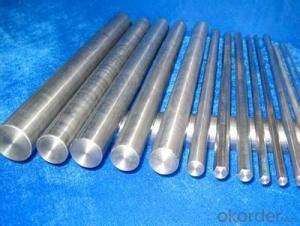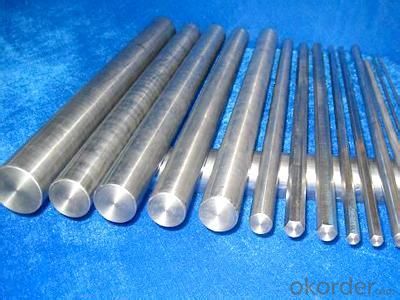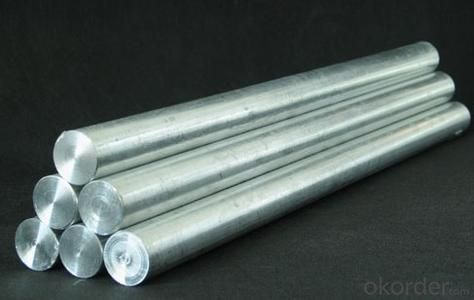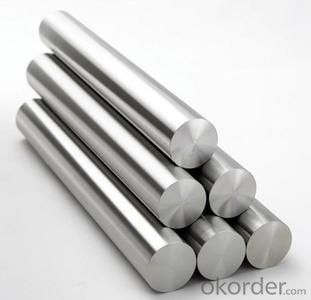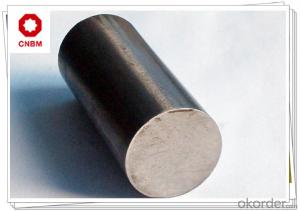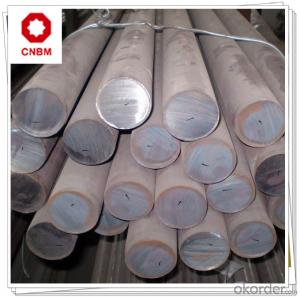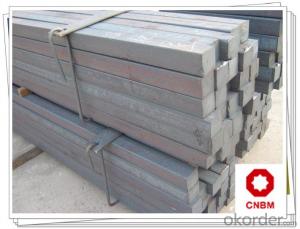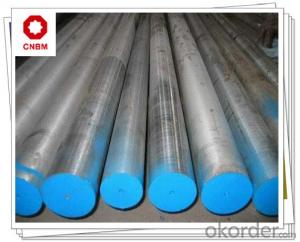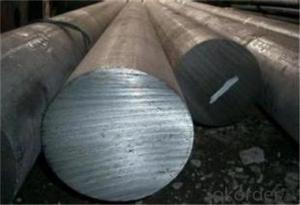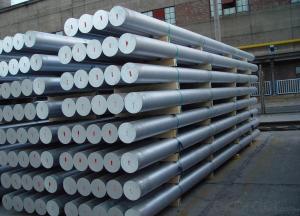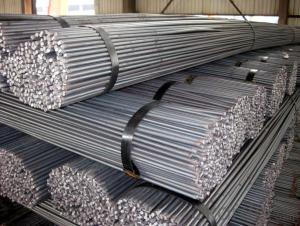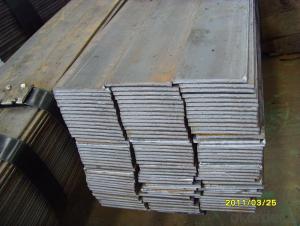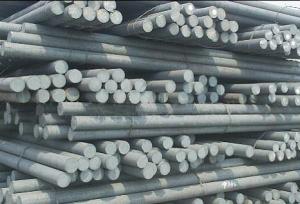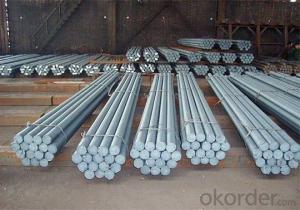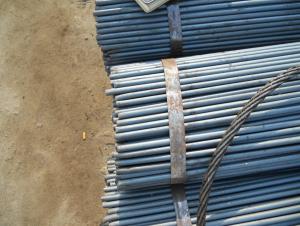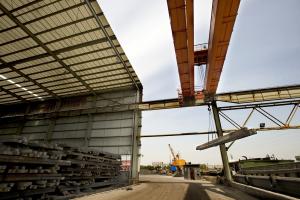Round Bar Q235 3MM-25MM High Quality Hot Rolled GB
- Loading Port:
- Shanghai
- Payment Terms:
- TT or LC
- Min Order Qty:
- 25 m.t.
- Supply Capability:
- 2000000 m.t./month
OKorder Service Pledge
OKorder Financial Service
You Might Also Like
OKorder is offering high quality Hot Rolled Steel I-Beams at great prices with worldwide shipping. Our supplier is a world-class manufacturer of steel, with our products utilized the world over. OKorder annually supplies products to European, North American and Asian markets. We provide quotations within 24 hours of receiving an inquiry and guarantee competitive prices.
Product Applications:
1) Suitable for making various strong cutting tool abrasion resistance, impact resistance.
2) Used to produce all kinds of high hard and super hard saw blade, drill, tap, broach, gear hob and various kinds of milling cutter.
3) Used for advanced punching die, screw die, and the toughness and complicated shape of the punch, etc.
4) Is used for cold forging die and drawing mode, etc.
5) Recommended watchcase factory, screw factory and other cold stamping products industry use.
Product Advantages:
OKorder's Steel I-Beams are durable, strong, and resist corrosion.
Main Product Features:
· Premium quality
· Prompt delivery & seaworthy packing (30 days after receiving deposit)
· Corrosion resistance
· Can be recycled and reused
· Mill test certification
· Professional Service
· Competitive pricing
Product Specifications:
1. Grade: GB, JIS, ASTM, EN
2. Grade: Q235, SS400, A36, S235JR
3. Diameter and mass: As below
Diameter | Mass | Diameter | Mass | Diameter | Mass |
(mm) | (kg/m) | (mm) | (kg/m) | (mm) | (kg/m) |
6 | 0.22 | 22 | 2.98 | 53 | 17.30 |
7 | 0.30 | 24 | 3.55 | 56 | 19.30 |
8 | 0.40 | 25 | 3.85 | 60 | 22.20 |
9 | 0.50 | 26 | 4.17 | 63 | 24.50 |
10 | 0.62 | 28 | 4.83 | 65 | 26.00 |
11 | 0.75 | 30 | 5.55 | 70 | 30.20 |
12 | 0.89 | 32 | 6.31 | 75 | 34.70 |
13 | 1.04 | 34 | 7.13 | 80 | 39.50 |
14 | 1.21 | 36 | 7.99 | 85 | 44.50 |
15 | 1.39 | 38 | 8.90 | 90 | 49.90 |
16 | 1.58 | 40 | 9.86 | 95 | 55.60 |
17 | 1.78 | 42 | 10.90 | 100 | 61.70 |
18 | 2.00 | 45 | 12.50 | 120 | 88.85 |
19 | 2.23 | 48 | 14.20 | 140 | 120.93 |
20 | 2.47 | 50 | 15.40 | 150 | 138.82 |
4. Material: Mild Steel
5. Heat treatment of high quality steel:
Fire: Isothermal annealing temperature is 800 ~ 880 °C, with 10 ~ 20 °C, the furnace cooling to about 600 °C, hardness above HB269.
Preheat temperature: 730-730 °C
Quenching temperature: 1190-1210 °C
Tempering temperature: 540-595 °C
Cold drawn, hardness 285 HBS
Cold drawn after annealing condition, hardness 277 HBS
Quenching methods: oil quenching, air cooling or salt bath quenching
FAQ:
Q1: Why buy Materials & Equipment from OKorder.com?
A1: All products offered byOKorder.com are carefully selected from China's most reliable manufacturing enterprises. Through its ISO certifications, OKorder.com adheres to the highest standards and a commitment to supply chain safety and customer satisfaction.
Q2: How do we guarantee the quality of our products?
A2: We have established an advanced quality management system which conducts strict quality tests at every step, from raw materials to the final product. At the same time, we provide extensive follow-up service assurances as required.
Q3: How soon can we receive the product after purchase?
A3: Within three days of placing an order, we will begin production. The specific shipping date is dependent upon international and government factors, but is typically 7 to 10 workdays.
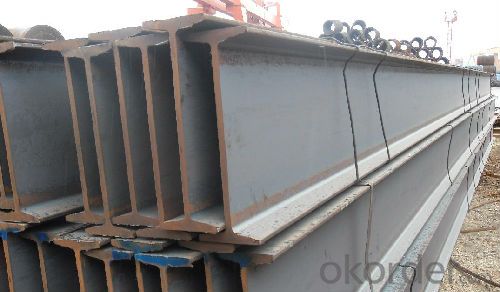
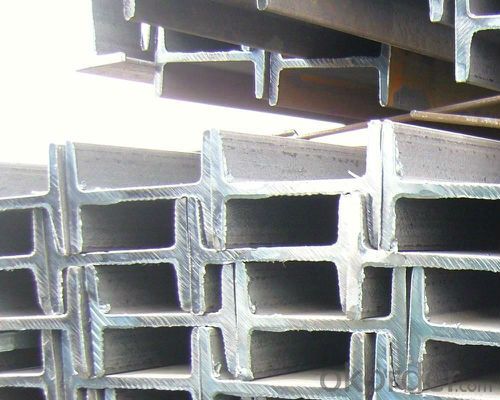
- Q: What are the different types of heat treatments used for steel round bars?
- The different types of heat treatments used for steel round bars include annealing, normalizing, quenching and tempering, and case hardening.
- Q: How do steel round bars resist corrosion?
- Steel round bars possess corrosion resistance due to a variety of factors. To begin with, steel itself is an alloy primarily composed of iron and carbon. By incorporating other elements like chromium, nickel, and molybdenum, the corrosion resistance of steel is enhanced. These additional elements create a protective oxide layer on the steel's surface, acting as a barrier against corrosive substances in the surroundings. Moreover, steel round bars can undergo further surface treatments or coatings to augment their corrosion resistance. One commonly used technique is galvanization, which involves coating the steel with a layer of zinc. This zinc coating serves as a sacrificial layer, deteriorating before the steel itself is affected. Additionally, steel round bars can be coated with epoxy or other polymer coatings to provide an additional layer of safeguarding. It is also crucial to recognize that the manufacturing process and quality of the steel round bars significantly influence their corrosion resistance. Proper heat treatment, refining techniques, and quality control measures guarantee a homogeneous microstructure and minimal impurities in the steel, thereby reducing the probability of corrosion. In conclusion, the combination of alloying elements, surface treatments, and high-quality manufacturing processes contribute to the corrosion resistance of steel round bars, rendering them a dependable choice for applications in corrosive environments.
- Q: Can steel round bars be used for making turbine blades?
- Using steel round bars to make turbine blades is not possible. Turbine blades experience high temperatures and extreme forces, so they need to be durable and flexible. Steel round bars do not have the required properties to endure these conditions. Usually, turbine blades are constructed from materials like titanium alloys or advanced composites, which have a high strength-to-weight ratio, exceptional fatigue resistance, and thermal stability. These materials are purposely designed to withstand the challenging conditions of turbine operations, ensuring efficiency and reliability.
- Q: What is the tolerance for length in steel round bars?
- The tolerance for length in steel round bars typically depends on the specific industry standards and requirements. However, in general, the tolerance for length in steel round bars can range from +/- 1/8 inch to +/- 1/4 inch, or even tighter tolerances depending on the application and specifications outlined by the manufacturer or customer.
- Q: How do steel round bars compare to plastic round bars?
- When comparing steel round bars and plastic round bars, it is important to note several key differences that impact their performance and suitability for different applications. Strength and durability play a significant role in determining the ideal choice for specific applications. Steel round bars are renowned for their exceptional strength and durability, making them perfect for applications that require high load-bearing capacity. They can withstand heavy loads without deforming or breaking. Conversely, plastic round bars are generally less strong and durable, making them more suitable for lighter applications where strength is not the primary concern. Weight is another factor to consider. Steel round bars are considerably heavier than plastic round bars due to differences in material density. This can be advantageous in applications where additional weight is desired for stability or balance. Conversely, plastic round bars are lighter and can offer benefits in weight reduction, which is particularly important in industries like aerospace or automotive. Corrosion resistance is a crucial consideration, especially in harsh environments or areas exposed to moisture. Steel round bars, particularly those made from stainless steel, are known for their excellent corrosion resistance. This makes them suitable for outdoor or corrosive environments. Conversely, plastic round bars are generally more susceptible to degradation caused by UV radiation, chemicals, or extreme temperatures. Consequently, they may not be as suitable for outdoor or corrosive environments. Versatility is yet another aspect to evaluate. Steel round bars offer a wide range of options in terms of size, shape, and grade. They can be machined, welded, bent, or shaped to suit various applications. While plastic round bars also come in different shapes and sizes, their versatility is somewhat limited compared to steel. They may not be as easily machined or welded, and their performance can be affected by temperature fluctuations. Cost is a significant factor to consider. Steel round bars are generally more expensive due to the higher costs associated with raw materials and manufacturing processes. On the other hand, plastic round bars are more affordable and can provide cost savings in certain applications. In conclusion, steel round bars offer superior strength, durability, and corrosion resistance, making them ideal for heavy-duty applications. Plastic round bars, on the other hand, are lighter, more affordable, and can be advantageous in applications where weight reduction is important. Ultimately, the choice between steel and plastic round bars depends on the specific requirements of the application and the trade-offs between strength, weight, cost, and corrosion resistance.
- Q: What are the different types of steel round bar finishes?
- There are several different types of steel round bar finishes, including hot rolled, cold drawn, turned and polished, and ground and polished.
- Q: What is the difference between a bright and a black steel round bar?
- The main difference between a bright and a black steel round bar is the surface finish. A bright steel round bar has a smooth and shiny surface due to the additional processing steps it undergoes, such as pickling or cold drawing. On the other hand, a black steel round bar has a rough and dark surface due to the absence of these additional processing steps. Additionally, the black steel round bar may also have a coating of oil or rust inhibitor to protect it from corrosion.
- Q: Are steel round bars suitable for automotive applications?
- Yes, steel round bars are commonly used in automotive applications due to their high strength, durability, and versatility. They are often used to manufacture components such as axles, crankshafts, and suspension systems, as they provide the necessary strength and support required for these critical automotive parts.
- Q: What is the difference between a seamless and a welded steel round bar?
- The main difference between a seamless and a welded steel round bar lies in their manufacturing process and the resulting structural integrity. A seamless steel round bar is produced by piercing a solid billet of steel and then rolling it into a round shape. This process ensures that there are no seams or welds in the bar, resulting in a smooth and continuous surface throughout its length. The absence of a weld eliminates the potential weaknesses and vulnerabilities associated with welded joints. Seamless steel bars are typically more uniform in composition and have a higher strength-to-weight ratio due to the absence of welds. On the other hand, a welded steel round bar is created by joining multiple pieces of steel together using various welding techniques. The steel pieces are heated and fused together at the edges to form a continuous bar. While the welding process provides flexibility in terms of length and diameter options, the presence of a weld can introduce certain structural concerns. Welded joints may be prone to defects, such as porosity or inclusions, which can compromise the overall strength and integrity of the bar. However, advancements in welding technology and quality control have significantly improved the reliability of welded steel round bars. In terms of applications, seamless steel round bars are often preferred in critical industries where high strength, reliability, and resistance to corrosion are essential. These industries may include oil and gas, aerospace, and automotive sectors. Welded steel round bars, on the other hand, are commonly used in less demanding applications where cost-effectiveness and availability are primary factors, such as construction, manufacturing, and general engineering. In summary, the key differences between seamless and welded steel round bars lie in their manufacturing process and resulting structural characteristics. Seamless bars are produced without any welds, offering a smoother surface, higher strength-to-weight ratio, and greater resistance to defects. Welded bars, while more cost-effective and readily available, may have weld-related vulnerabilities that need to be considered depending on the application. Ultimately, the choice between the two depends on the specific requirements and priorities of the intended use.
- Q: What are the different heat treatment methods for steel round bars?
- Steel round bars can undergo various heat treatment methods to enhance their mechanical properties and overall performance. These methods, namely annealing, normalizing, quenching, tempering, and case hardening, are commonly employed. 1. Annealing: By subjecting the steel round bars to a specific temperature and maintaining it for a certain duration, annealing achieves a uniform microstructure. This treatment alleviates internal stresses, improves ductility, and enhances machinability. 2. Normalizing: This technique involves heating the steel round bars slightly above their critical transformation temperature and subsequently cooling them in still air. Normalizing refines the grain structure, enhances mechanical properties, and improves resistance to impact and fatigue. 3. Quenching: The process of quenching entails heating the steel round bars above their critical temperature and rapidly cooling them by immersion in a quenching medium like oil, water, or brine. This rapid cooling hardens the steel, rendering it stronger and more resistant to wear and abrasion. However, quenched steel may exhibit brittleness, necessitating additional heat treatment steps. 4. Tempering: Following the quenching process, tempering is often employed to reduce brittleness and enhance toughness. Tempering involves reheating the quenched steel to a specific temperature and holding it there for a designated time, followed by gradual cooling. This procedure alleviates internal stresses, improves ductility, and enhances overall toughness and machinability. 5. Case Hardening: Case hardening is a surface heat treatment method that increases the hardness of the outer layer of steel round bars while maintaining a relatively softer core. This technique involves heating the steel in a carbon-rich environment, such as a gas or salt bath, and subsequently quenching it to achieve a hardened outer layer. Case hardening improves wear resistance and fatigue strength, making it suitable for applications requiring high surface hardness. It is crucial to note that the selection of the specific heat treatment method for steel round bars depends on the desired mechanical properties and intended application. Manufacturers meticulously choose the appropriate heat treatment method based on factors such as steel composition, desired hardness, and required strength.
Send your message to us
Round Bar Q235 3MM-25MM High Quality Hot Rolled GB
- Loading Port:
- Shanghai
- Payment Terms:
- TT or LC
- Min Order Qty:
- 25 m.t.
- Supply Capability:
- 2000000 m.t./month
OKorder Service Pledge
OKorder Financial Service
Similar products
Hot products
Hot Searches
Related keywords
